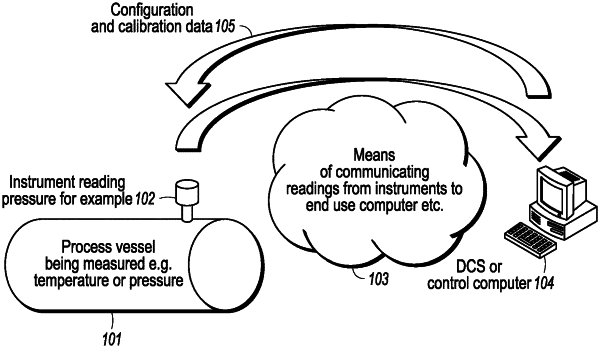| CPC H04L 41/0816 (2013.01) [H04L 9/3247 (2013.01); H04L 12/2807 (2013.01); H04L 63/0442 (2013.01); H04L 67/12 (2013.01); H04L 2012/2841 (2013.01)] | 9 Claims |

|
1. A method of connecting an instrument to a network, comprising:
functionally connecting a master device to a network;
routing first data from a network node to the master device using a topology comprising a pathway having a first end at the network node and a second end at the master device;
functionally connecting an instrument to the master device;
representing the instrument to the network as a sub-instrument of the master device;
functionally connecting the instrument to the network; and
routing second data from the network node to the instrument using the topology and the pathway,
wherein the message is digitally signed, and functionally connecting the instrument to the network comprises the network recognizing a connection of a sub-instrument and maintaining the topology used before the instrument was represented to the network,
further comprising the steps of:
creating a message which includes (a) data recorded by the instrument and (b) information about the instrument, wherein the instrument is a first instrument;
transmitting the message to a second instrument;
extracting from the message the data recorded by the first instrument and the information about the first instrument; and
using the data recorded by the first instrument and the information about the first instrument to verify that the data read value is both correct and correctly calculated,
wherein the message is digitally signed, and functionally connecting the instrument to the network comprises the network recognizing a connection of a sub-instrument and maintaining the topology used before the instrument was represented to the network;
further comprising the steps of:
creating public keys and private keys for instruments and computers and recording them in a repository, where each instrument or computer can access only its own private keys, but can access all public keys;
performing a first encryption (stage 1) by digitally signing the message by taking the message along with the private key of the instrument or computer from which the message was created to encrypt the message,
then performing a second encryption by taking an intended recipient's public key from the repository, and encrypting the result of the first encryption (stage1) using the intended recipient's public key (stage 2), which constitutes a signing of the message;
sending the message to the intended recipient's instrument or computer;
decrypting the second encryption at the intended recipient's instrument or computer by using the private key of the intended recipient's instrument or computer to unencrypt the stage 2 message into the stage 1 message undoing the last encryption that was done; and
the intended recipient's instrument or computer then tries public keys of a list of possible senders each in turn on the stage 1 message and finds only the public key of the instrument or computer from which the message was created will undo the first encryption and provide clear (unencrypted) text
and
wherein the instrument comprises a wireless sensor:
having a case made of stainless steel and glass;
having no integral visual display other than at least one signal light;
including the at least one signal light;
including a wireless transceiver for allowing remote read and remote control of the sensor; and
including piezoelectric pressure detectors for allowing a user to locally interact with the sensor by pressing on the case.
|